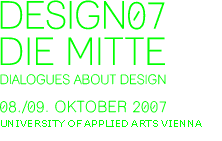DESIGN 07 – on design and the middle
Design, the sum of the techniques that determine the appearance of our material and visual culture, is closely related to societal developments. Therefore any examination of design must deal with cultural, social, economic and aesthetic aspects.
DESIGN 07 – THE MIDDLE is, on the one hand, devoted to the middle of this society, the imaginary average consumer. In the 1950s this middle was still seen as uniform and progressive – everyone had a share in a minimum of prosperity and consumer culture, the most popular consumer goods of this period often became design icons. Today there is a talk of a “loss of the middle class”: it is not only the fact that under the present neo-liberal conditions a share in average prosperity can no longer be taken for granted, the middle as a place of consumption – which it still remains today – seems increasingly difficult to define. The individualisation of life patterns and styles increasingly blurs the outlines of this middle. How should and can product design for the middle look today?
In the consumer goods industry there is also talk of the disappearance of the middle, while increasing concentration and the disappearance of small and medium-sized producers create the impression that hardly anything exists between the luxury and the discount sectors. Is the time when it was possible to choose from differently designed, reasonably priced items of real quality finally past? And are new forms of consumption – such as online shopping or Ebay – not a reaction to this? What impact does this development have on the design world, on training, the images of professions, and criteria of success? How does the design world think about these issues and how does it react to them?
Additionally DESIGN 07 intends to explore the concept of the middle by means of association, as this term has a number of very different and apparently contradictory connotations. On the one hand it suggests the mediocre, that which is somehow or other outdated, everything that is not cutting edge, avant-garde or trendy – all terms that still strongly influence the reception of design. But could the middle not also be identified with an appropriate or measured approach that deliberately avoids such criteria, focusing instead on suitability for everyday life, usefulness and sustainability?
A further interpretation of the middle is an area of harmony and balance, what is known as the golden mean that illustrates a harmony that the designer must first achieve. Looking at the formation of the canon in the area of design might what is called “timeless design” ( beyond any trends) possibly be found here? Which criteria create this kind of collectively experienced harmony in, say, a design object?
These questions and others dealing with the area of design and the middle will be pursued on 8 and 9 October, with the goal of linking the discussion to current design theory and practice.
DESIGN 07 - idea and format
The conference invites visitors to take the time to look more closely at the various reference points of design and the middle and to develop a deeper understanding within the framework of an intensive programme. Nevertheless it is seen as an event that offers approaches to themes but no patent recipes and definitive answers. Conference visitors determine their own focal points and consequently each visitor experiences the conference in his or her own way.
The dialogues about the middle and design are aimed at a specialist design public as well as at interested members of the general public. The choice of speakers guarantees a discussion of these themes at a broad, varied and practical level – from highly specialised insights to the broad overview. The involvement of business men and women, specialists from museums as well as teachers illustrates how the approaches taken are interconnected. The programme is intended as a clear commitment to design as a cultural factor that includes what are known as the “creative areas” of art and design as well as business and the economy and indeed underlines the fact that they cannot be separated from each other.
Starting from an understanding of design as applied art we look for a way of conveying and explaining design that is both creative and applicable. Design has the inherent advantage of speaking in a very direct way through its products, it should be legible and understandable for its users or consumers. The question was how to achieve this kind of immediacy within the context of a design conference, and the idea of replacing lectures by dialogues seemed a right step in this direction. The aim is, above all, to intensify the points of contact of the areas of design practice and theory (that are so often separated) in the form of dialogues.
The conference days are structured according to a matrix system. As the discussion rounds are held parallel to each other in three different rooms, conference visitors are offered a variety of opportunities to organise their own conference programme. Visitors are challenged to decide upon a strategy and dramaturgy for their visit to the conference.

